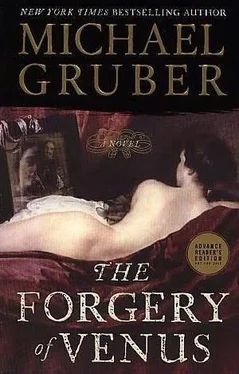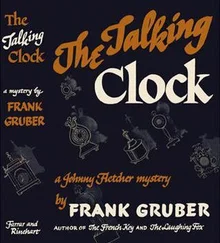I went into rehab like a good boy and did my program, but when I got out she said she couldn’t live with me anymore, she couldn’t carry the weight of the demons. I moved back into my loft then, and since then I’ve been living from check to check, magazine work mainly, newspapers, a few ads, never enough, sinking ever deeper into plastic hell, IRS hell…
Maybe.
That brings us up to last summer, a day in June; I was at Vanity Fair that day talking to Gerstein, the art editor, about a project they wanted to do, a series of pieces on the great beauties of the day illustrated with oil portraits in the manner of the great masters. They got the idea, of course, from the movie Girl with a Pearl Earring, Vermeer and Scarlett Johansson, that was the hook: Madonna by Leonardo (ho ho!), Cate Blanchett by Gainsborough, Jennifer Lopez by Goya, Gwyneth Paltrow by Ingres, Kate Winslet by they hadn’t decided yet. And he thought of me, naturally, and he went on and on about how he had to fight management to get to do them as real paintings rather than Photoshopped photos, and I asked him had they agreed to pose, and he looked at me funny and said of course they’re not going to pose, you’ll work from existing photographs. I argued with him for a while but it’s impossible to get anyone, especially a magazine fart director, to understand the difference between a posed portrait and one cocked up from photographs, and he knew I needed the money, so we shook on it, $2,500 per, a bargain. I suggested Velázquez for Kate Winslet and he said great idea. I called Lotte and told her about the sale, just to hear her happy with me for once, and she was. I could practically hear her mental calculator clicking over the phone.
There was a fairly short deadline on the project, and by the time I got back to the loft I was thinking about painting and trying not to think about where in the bottomless money pit I was going to stuff that twelve and a half grand. Since I turned whore I have all the art books, and it’s kind of cool to look through them and summon up the originals I’ve seen. The funny thing is I know that when I actually have the palette set up and brush in hand I won’t give a shit what the finished product is, I’ll be stoned off the process of painting.
Lotte, in her art gallery head, used to calculate that I made about eight bucks an hour with the kind of work I put into a project, and I could never explain to her why I do it, why I have to work like that in order to get out of bed every morning, because I knew what she would say. She would say, why don’t you paint then for yourself, Chaz, and give up this connerie ? Then I’d get mad and say, how the fuck are we going to pay for Milo’s goddamn pills, five grand a month at least, and are you going to pull that out of your little gallery? And then she’d say, but I can sell your work, your work is wonderful, people would love to have your work. And there it would sit, like a fresh turd on the table, the thing that busted us up, Chaz Wilmot’s principled refusal to paint real work for the commodity market. So I would storm out to the studio and work on a magazine cover or a record album and smoke dope until everything seemed just peachy.
I was just sitting down with a book of Ingres portraits when the phone rang and it was a secretary asking me if I would hold for Dr. Zubkoff, and my belly dropped because I thought it was one of Milo’s docs with more bad news. So when he came on and I figured out who it was and found out what he wanted, I was so relieved that I would have agreed to practically anything.
The next day I took the subway up to the Columbia medical school campus and walked to the building I’d been told to find, a four-story brick-and-glass structure on St. Nicholas Avenue at 168th Street. Inside, the usual medical smell, the over-cooled reception room with the tattered magazines, the white-coated receptionist behind her little window. They were expecting me. I filled out a medical form, lied about my drug use and my smoking like everyone else, and was turned over to a nurse in pale blue scrubs who took me into a little room and told me to get into a gown. They said they wanted to make sure I was totally disease-free before they let me into a major drug study, so if I had a prior condition I couldn’t come back at them with an accusation that their drug messed me up.
A couple of hours later, I found I was healthy, despite my lifestyle, still sound as a bell, apparently, just like Krapp. It was an impressive medical workup, bloods, scans, the whole nine yards, and after it I had an even greater sympathy for my poor kid.
After all the tests were done and I was dressed again, they led me to a small conference room with the other guinea pigs and I saw Shelly himself, now a far cry from the pale slug he was in college, a man with a tan and longer hair, with the flossy rich-guy cut they all have and that aura of authority they must bolt on when they give out the med school diplomas. A dozen or so people in the room, all arty types, about evenly divided between the sexes, mostly younger than me. It looked like Sunday brunch at any hip place in Williamsburg.
Dr. Z took us through a PowerPoint show about salvinorin A, the drug we were about to pollute our bodies with. On the screen a picture of some dusty Indians sitting around in a circle, Mazotecs from the deserts of Oaxaca, who used a plant called Salvia divinorum, the diviner’s sage; their shamans used it to break loose from time and see the future and the past. Silly them, because according to Shelly it was all happening in the damp meat of their brains, like everything else we perceived. Over the last few decades, researchers had extracted the active principle of the Indian herb-salvinorin-and discovered that it was not an alkaloid like most of the psychoactive drugs, but a much smaller molecule, a diterpene, and unique in that respect. It was a kappa opioid agonist, I recall that, something to do with the control of perception. The drug had a variety of different effects, we learned, and these varied considerably between users. Of particular interest, though, was its ability to create the illusion that you were reliving a portion of your earlier life. Dr. Z said he thought that since the retention of childlike wonder and freshness of perception was widely considered to be a central element in the creative process, maybe salvinorin might enhance it, which was why he’d selected his subjects from artists and musicians. Then there was some technical stuff about how if they got psychological effects they would use tracers and so forth to try to pinpoint the areas of the brain that did creative stuff, and then he closed with assurances that while the drug was extremely potent, it appeared to be quite safe and nonaddictive.
Then the usual questions from the floor, which Shelly handled, I thought, with a smoothness that had not been apparent in him as an undergrad, and the meeting broke up. I went up to him afterward and we shook and did the whole small world thing, and he invited me for a private chat in his office. Which was very nice, golf clubs in the corner, all kinds of awards, blond wood desk and chairs, flat-screen monitor, framed kids’ drawings on the walls and a small amateur oil of flowers in a vase, maybe by the wife, a happy family man it seems, good for Shelly. No talk about old times; he boasted and I listened. His great career, his beautiful family, his house in Short Hills. He said he saw my stuff in the magazines all the time, he thought it was great. He thought I was a success, just like him.
He said he particularly wanted me in this study because it was really going to penetrate to the roots of creativity and even lead to ways of augmenting it. I thought that if he wanted to do that he better bring his lunch, but I didn’t say anything; why rain on the guy’s parade? I was happy for him, the poor schmuck, and it was a hundred bucks a session to me.
Читать дальше












